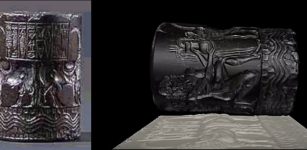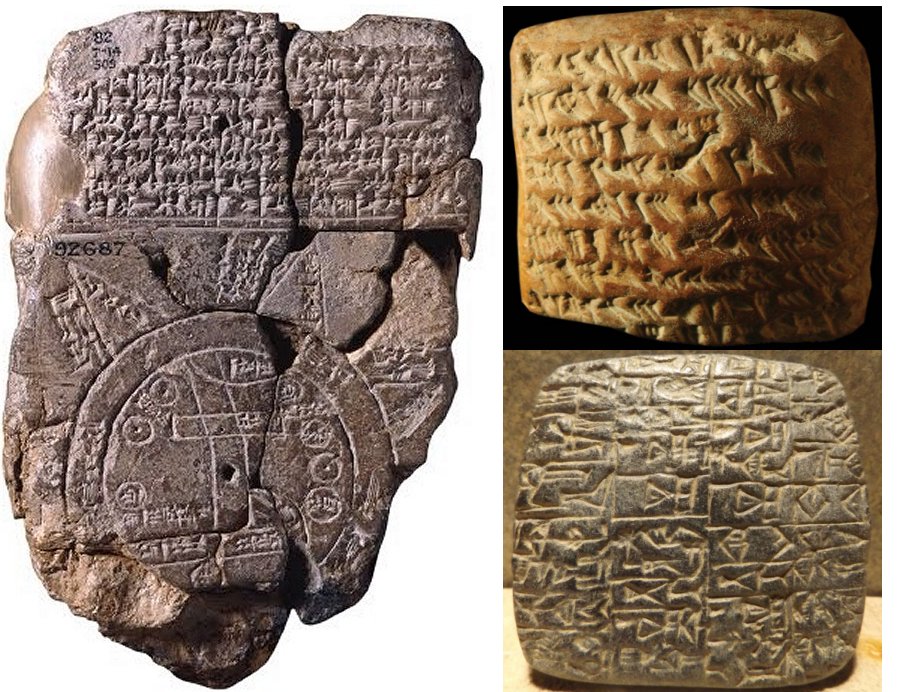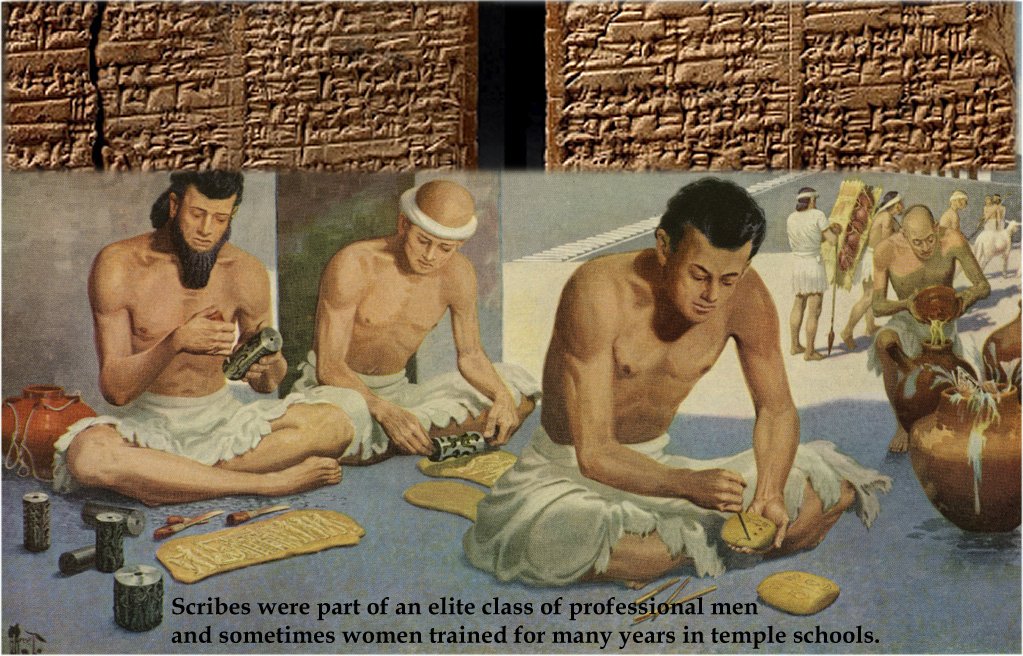Cuneiform Tablets: One Of The Earliest Systems Of Writing Invented By The Sumerians
A. Sutherland - AncientPages.com - A Sumerian epic poem entitled "Inanna and Enki" says that the art of writing was among many essential elements of civilization, transferred from Eridu, the City of the Kings, to Uruk. It was dedicated to the people of earth by Enki, God of Wisdom.
According to Mesopotamian beliefs, writing is considered a gift of the gods, and writing means both power and knowledge.
Archaeological evidence, on the other hand, suggests that the Sumerians have developed this excellent skill for a long time. The invention of writing, dating from 5000 BC to 2000 BC, was used for keeping accounts, describing religious events and scientific achievements, and keeping records of extraordinary happenings, known today as written history.
More than 5,000 years ago, people living in Mesopotamia developed a form of writing to record and communicate different types of information. The early writing was based on pictograms, which helped share basic information about crops and taxes.
Several scientists worldwide examined the inscribed tablets and could date their creation to at least 6,500 years ago. However, many believe that the Tartaria tablets represent the first writing in the world. Their existence suggests that the Danube civilization invented a writing system long before the Sumerians.
Mesopotamian cuneiform writing was made with the help of the stylus to make wedge-shaped marks in the clay. Using this method over thousands of years, Mesopotamian scribes recorded on clay tablets - daily events, trade, and the numbers of sheep, cattle, crops, and laborers in the workforce, because trade and economic necessities were likely the biggest motivators for writing.
Many cuneiform tablets were later covered with astronomy, texts of omen collections, medical texts, and therapeutic, symptom, and disease texts. Later, the Babylonians wrote sophisticated mathematical procedures in cuneiform script on clay tablets.
Later, the pictogram signs were replaced with the so-called 'cuneiform script' that dates back to the late fourth millennium BC. The Sumerians are credited with this invention, one of the earliest writing systems.
Also, the earliest known dictionaries in the world developed when people needed to translate words in Sumerian into Eblaite since Ebla was a major educational center. However, literature was not intended for a broad audience but rather for the royal collections and school libraries used for studies and teaching.
The Sumerian script was also adapted for writing the Akkadian, Elamite, Hittite, Luwian, Hattic, Hurrian, and Urartian languages. It became an inspiration for the Ugaritic alphabet and Old Persian cuneiform. The cuneiform writing system was used for over 3000 years, and during at least 2000 years, the system underwent considerable changes.
The primary material on which the records were made was clay, abundant in Mesopotamia. It is worth adding that more Sumerian texts could be preserved compared to the Egyptians. It is because clay tablets had much better durability than the Egyptian writing material – papyrus.
The Phoenician alphabet gradually replaced cuneiform writing during the Neo-Assyrian Empire (911–612 BC). By the second century CE, the script had become extinct. All knowledge of how to read it was lost until the deciphering process began in the 19th century.
 World’s oldest dictionaries come from the Akkadian Empire. The dictionaries, written on cuneiform tablets, are about 4,500-year-old and were discovered in Ebla. The Urra=hubullu glossary, a major Babylonian glossary or encyclopedia from the second millennium BC, preserved in the Louvre Museum in Paris.
World’s oldest dictionaries come from the Akkadian Empire. The dictionaries, written on cuneiform tablets, are about 4,500-year-old and were discovered in Ebla. The Urra=hubullu glossary, a major Babylonian glossary or encyclopedia from the second millennium BC, preserved in the Louvre Museum in Paris.
When the Sumerian state ceased to exist, the Babylonians and the Assyrians took over the entire cultural heritage. In legacy, the Sumerians left numerous magical and historical texts, mathematical-natural, philological, and astrological-astronomical textbooks.
Many of these texts were copied, and new ones were created, but these works remained anonymous. The first early attempts at deciphering the cuneiform tablets were also largely unsuccessful because it was difficult to determine the origin of many of them.
Archaeologists unearthed many thousands of cuneiform tablets. One example is the discovery of 30,000 clay tablets found in Nineveh, one of the essential sources of knowledge about ancient Mesopotamia.
 Letter sent by the high-priest Lu’enna to the king of Lagash (maybe Urukagina), informing him of his son's death in combat. w: Clay tablet, c. 2400 BC, found in Telloh (ancient Girsu). From the excavations supervised by Gaston Cros, 1904. Photo credit: Jastrow/Louvre Museum - Public Domain
Letter sent by the high-priest Lu’enna to the king of Lagash (maybe Urukagina), informing him of his son's death in combat. w: Clay tablet, c. 2400 BC, found in Telloh (ancient Girsu). From the excavations supervised by Gaston Cros, 1904. Photo credit: Jastrow/Louvre Museum - Public Domain
The Sumerian script was also adapted for the writing of the Akkadian, Elamite, Hittite, Luwian, Hattic, Hurrian, and Urartian languages. It became an inspiration for the Ugaritic alphabet and Old Persian cuneiform. The cuneiform writing system was used for more than 3000 years, and during at least 2000 years, the system underwent considerable changes.
The basic material on which the records were made was clay, which was abundant in Mesopotamia. It is worth adding that more Sumerian texts could be preserved compared to the Egyptians. This is due to the fact that clay tablets had much better durability than the Egyptian writing material – papyrus.
The Phoenician alphabet gradually replaced cuneiform writing during the Neo-Assyrian Empire (911–612 BC). By the second century CE, the script had become extinct, and all knowledge of how to read it was lost until it began to be deciphered in the 19th century.
When the Sumerian state ceased to exist, the entire cultural heritage was taken over by the Babylonians and the Assyrians. In legacy, the Sumerians left numerous magical and historical texts, mathematical-natural, philological, and astrological-astronomical textbooks.
Many of these texts were copied, and new ones were created, but these works remained anonymous. The first early attempts at decipherment of the cuneiform tablets were largely unsuccessful also because it was difficult to determine the origin of many works.
By the end of the 1850s, Hincks and Rawlinson had successfully provided a working decipherment of Mesopotamian cuneiform. Their contribution formed the foundation of our knowledge of the Sumer, Akkadian, Babylonian, and Assyrian empires, all native to Mesopotamia.
Written by – A. Sutherland AncientPages.com Staff Writer
Updated on October 3, 2022
Copyright © AncientPages.com All rights reserved. This material may not be published, broadcast, rewritten or redistributed in whole or part without the express written permission of AncientPages.com
Expand for referencesReferences:
Beckett, T. Sumerians: Discover History’s First Civilization
Freeman, H. Sumerians: A History From Beginning to End
King, L. W. A History of Sumer & Akkad
More From Ancient Pages
-
 Artifacts From Shakhi Kora Reveal The Rejection Of Early Centralized Governance In Ancient Mesopotamia
Archaeology | Dec 9, 2024
Artifacts From Shakhi Kora Reveal The Rejection Of Early Centralized Governance In Ancient Mesopotamia
Archaeology | Dec 9, 2024 -
 Choctaw Indians’ Legend Of Nanih Waiya Cave Mound – Mysterious Underground Realm Of Their Ancestors And Their Battle With Giants
Featured Stories | Aug 3, 2017
Choctaw Indians’ Legend Of Nanih Waiya Cave Mound – Mysterious Underground Realm Of Their Ancestors And Their Battle With Giants
Featured Stories | Aug 3, 2017 -
 Ancient Mayans Used Saunas For Healing Purposes
Ancient History Facts | May 12, 2016
Ancient Mayans Used Saunas For Healing Purposes
Ancient History Facts | May 12, 2016 -
 Sleipnir: Eight-Legged Horse With Supernatural Strength That Belonged To God Odin
Featured Stories | Mar 21, 2017
Sleipnir: Eight-Legged Horse With Supernatural Strength That Belonged To God Odin
Featured Stories | Mar 21, 2017 -
 Ancient Hindu Sheetal Temple Vandalized – Lord Shiva And Elephant God Ganesha Statues Destroyed
News | Nov 3, 2020
Ancient Hindu Sheetal Temple Vandalized – Lord Shiva And Elephant God Ganesha Statues Destroyed
News | Nov 3, 2020 -
 Mystery Of The 290-Million-Year-Old Zapata Footprint In New Mexico
Featured Stories | Sep 23, 2020
Mystery Of The 290-Million-Year-Old Zapata Footprint In New Mexico
Featured Stories | Sep 23, 2020 -
 Blood Of St. Januarius – One Of The Most Remarkable Christian Relics
Artifacts | Jun 27, 2017
Blood Of St. Januarius – One Of The Most Remarkable Christian Relics
Artifacts | Jun 27, 2017 -
 Early Human Communication May Have Been Influenced By Changing African Landscape – Anthropologists Say
Evolution | Dec 28, 2023
Early Human Communication May Have Been Influenced By Changing African Landscape – Anthropologists Say
Evolution | Dec 28, 2023 -
 Pyramid Of Unknown Ancient Egyptian Queen And Hundreds Of Mummies Discovered In Saqqara
Archaeology | Nov 17, 2022
Pyramid Of Unknown Ancient Egyptian Queen And Hundreds Of Mummies Discovered In Saqqara
Archaeology | Nov 17, 2022 -
 Death Of Norse God Balder And Loki’s Mischief That Led To Destruction In Ragnarok
Featured Stories | Nov 15, 2016
Death Of Norse God Balder And Loki’s Mischief That Led To Destruction In Ragnarok
Featured Stories | Nov 15, 2016 -
 Early Twelfth-Century Castle Walls Unearthed Outside Gloucester, England
Archaeology | Dec 9, 2015
Early Twelfth-Century Castle Walls Unearthed Outside Gloucester, England
Archaeology | Dec 9, 2015 -
 Impressive Pyramid Of Kukulkan (El Castillo’) At Chichen Itza
Civilizations | Feb 7, 2017
Impressive Pyramid Of Kukulkan (El Castillo’) At Chichen Itza
Civilizations | Feb 7, 2017 -
 Ancient City Of Hippos-Sussita And The Mysterious Disc-Shaped Copper Plates
Archaeology | Apr 18, 2017
Ancient City Of Hippos-Sussita And The Mysterious Disc-Shaped Copper Plates
Archaeology | Apr 18, 2017 -
 Ice Age Mystery – Unexplained Disappearance Of North America’s Large Mammals – New Clues
Fossils | Jun 1, 2024
Ice Age Mystery – Unexplained Disappearance Of North America’s Large Mammals – New Clues
Fossils | Jun 1, 2024 -
 Sharkalishharri Cylinder Seal From The Fifth King Akkad Dynasty
Artifacts | Feb 14, 2016
Sharkalishharri Cylinder Seal From The Fifth King Akkad Dynasty
Artifacts | Feb 14, 2016 -
 Ancient Nessebar – 3,000-Year-Old History Of Many Civilizations
Featured Stories | Jan 10, 2016
Ancient Nessebar – 3,000-Year-Old History Of Many Civilizations
Featured Stories | Jan 10, 2016 -
 Pax Mongolica: Time Of Peace And Stability That Helped To Spread Technologies And Inventions
Ancient History Facts | Mar 28, 2016
Pax Mongolica: Time Of Peace And Stability That Helped To Spread Technologies And Inventions
Ancient History Facts | Mar 28, 2016 -
 Rare Stone Age Artifacts Found In Norway Offer Evidence Of Migration From The East
Archaeology | Aug 24, 2023
Rare Stone Age Artifacts Found In Norway Offer Evidence Of Migration From The East
Archaeology | Aug 24, 2023 -
 Yazılıkaya: One Of The Most Striking Religious Shrines Of The Hittite Empire
Featured Stories | Jul 4, 2023
Yazılıkaya: One Of The Most Striking Religious Shrines Of The Hittite Empire
Featured Stories | Jul 4, 2023 -
 Oldest Indo-European Calendar Based On The Orion Constellation Is Engraved On A Vucedol Vessel
Artifacts | Jun 7, 2021
Oldest Indo-European Calendar Based On The Orion Constellation Is Engraved On A Vucedol Vessel
Artifacts | Jun 7, 2021


